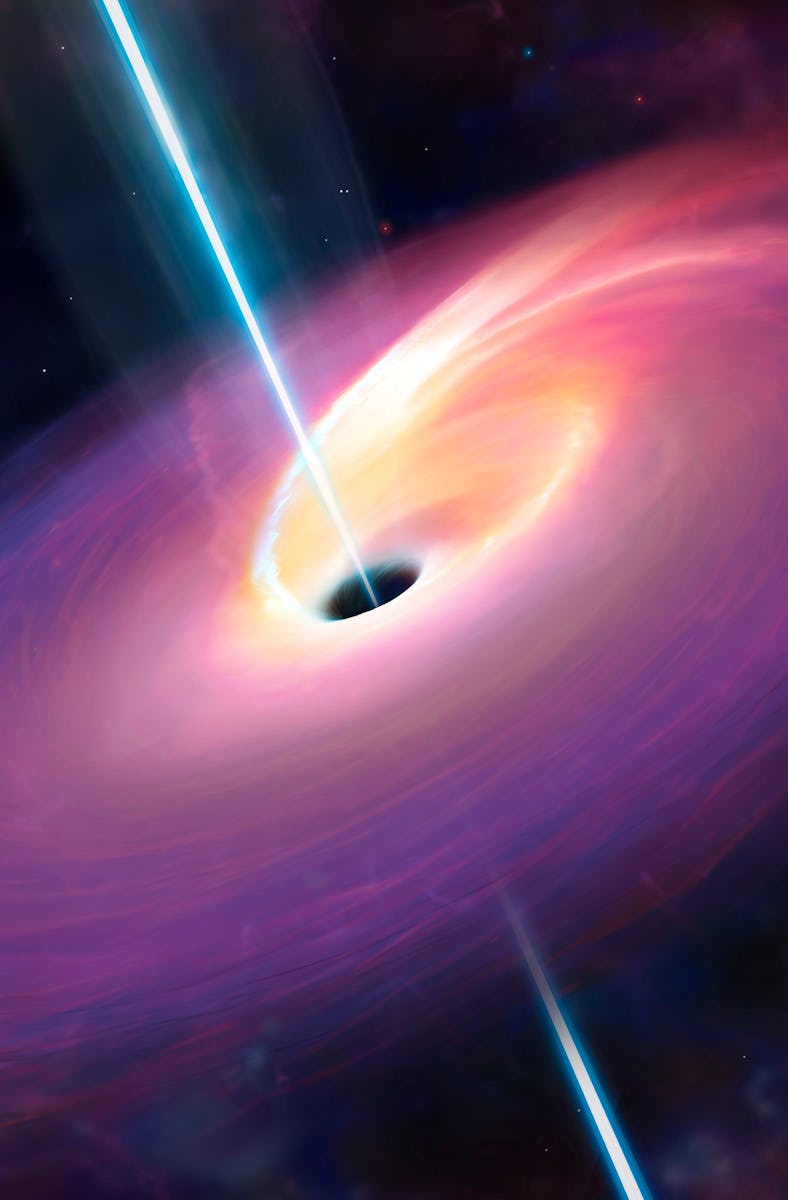Messy Plasma Streams Could Explain How Supermassive Black Holes Influence Galaxies
The afterglow of black holes may offer a huge clue to their relationship with their host galaxies.

Although supermassive black holes often look similar, each one devours material differently. One may gulp down whole stars’ worth of material every year, while others nibble slowly — taking millions of years to swallow mass equivalent to our Sun. But no matter how differently they feed, all supermassive black holes tend to emit the same radiation, and now a new survey of these galactic gourmands could help explain their outsized influence on their home galaxies.
Black holes themselves are so dense that even light can’t escape their gravity, but the space around them is a brilliant tangle of radiation. Cardiff University astrophysicist Ilaria Ruffa and her colleagues recently studied the light around actively feeding supermassive black holes at the centers of 136 galaxies. The resulting radiation of their messy feasts could help measure the mass of the black hole and unravel the mystery of its influence on the rest of the galaxy.
On Tuesday the scientists published their work in the Monthly Notices of the Royal Astronomical Society Letters.
This image shows the aftermath of the accretion of a star by a supermassive black hole.
Different Appetites, Same Healthy Glow
To conduct the study, Ruffa and her team used the Atacama Large Millimeter/submillimeter Array to study the X-ray and microwave radiation coming from monster supermassive black holes feasting on gas, dust, and even the occasional star.
Until recently, it seemed that a black hole’s eating habits determined how much, and in what wavelengths, the area around it should glow. Because the material around the black hole – not the black hole itself – is what emits radiation, the material falling into the black hole in different ways (and in different amounts) should produce different light.
However, this new study shows that black holes with very different appetites glow in the same way, whether the matter falling into them is a thin dribble or a wide, fast-spinning accretion disk. It turns out that messy streams of plasma (hot, electrically-charged gas) flowing into the supermassive black hole produce a similar microwave and X-ray afterglow no matter how fast the black hole is feeding.
The glow’s wavelengths and brightness depend on the black hole’s mass, not its appetite, and that means astrophysicists can use that radiation to measure the mass of these celestial monsters.
Enigmatic Galactic Influencers
We tend to think of supermassive black holes as leviathans lurking at the center of galaxies, dominating everything with their irresistible gravity and voracious hunger — but even an actively feeding supermassive black hole isn’t as gargantuan as it sounds.
“They are really very small and lightweight in the context of an entire galaxy,” says Cardiff University astrophysicist Timothy Davis, a coauthor of the recent study, in a statement. “And yet they have a mysterious non-gravitational influence over material tens of thousands of light years away from them.”
That influence can shape how and where stars form in the galaxy, among other things. This is partly due to the fact that black holes are extremely messy eaters, and they tend to throw their food at nearly the speed of light, sometimes flinging material away from the galaxy and tossing it back into the mix of interstellar gas. It’s a complicated cosmic dance, and it’s only part of the story of how supermassive black holes shape the evolution of their galaxies.
The best way to solve that mystery, according to Ruffa, is to better understand supermassive black holes themselves. Black holes only have three properties — mass, spin, and electrical charge — so solving the mass part of the equation would be a big leap.
Because the X-ray and microwave radiation that Ruffa and her colleagues measured is directly related to the black hole’s mass, measuring that radiation could be a good way to “weigh” a supermassive black hole. And those resulting measurements could give astrophysicists a whole new understanding of these supermassive and super-important galactic influencers.